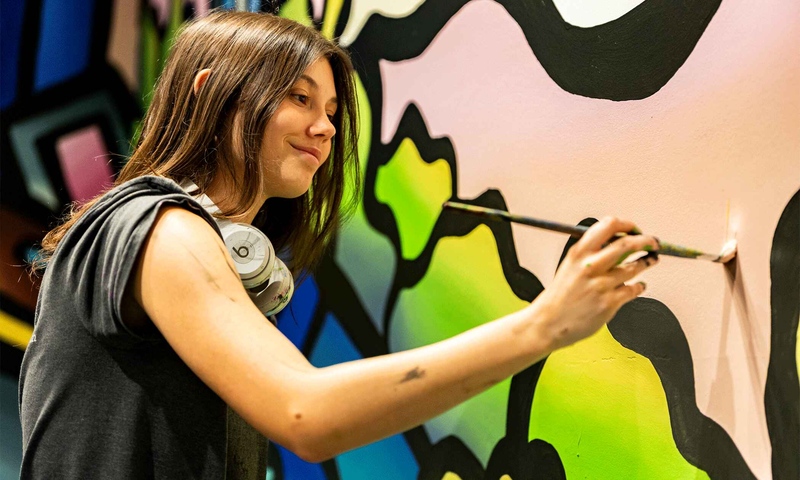In preparation for the inaugural Mineral Cup, Anastasia Wood ’25 and Caroline Lopez ’25 understood that no stone could be left unturned.
All their classmates would collect astonishing nuggets of information about the 19 minerals represented in the single-elimination tournament for professor Erik Klemetti’s Rocks, Minerals, and Soils class. Each team would produce slick presentations to illustrate their academic discoveries.
But as Wood and Lopez — touting the wonders of serpentine — ambled into a crowded first-floor classroom, competitors realized the level of detail they were up against. The two juniors wore matching lime green “Team Serpentine” T-shirts they designed themselves.
“Sorry, we don’t have T-shirts, y’all got us there,” Valeria Benitez ’25 said during a first-round matchup between serpentine, known as the Serpent Rock for its sometimes scaly appearance, and rutile, an oxide mineral popular in manufacturing sectors.
Benitez’s concession drew laughs on a night that highlighted Denison’s commitment to finding imaginative and innovative ways to teach its students.
The Mineral Cup was a rousing success, a two-hour event that combined education, entertainment, and engagement. Seventy-five students, some sitting in the aisles, used a QR code to vote for the winners of each round.
Every presentation was met with applause from fellow competitors and their friends, who had come to support the contestants and dine on free pizza. One student held a multi-colored sign reading: “Spodumene Is The Best Mineral.”
“Honestly, when so many people that you know come out, and they’re cheering you on, it makes it a lot more fun,” said George Fox ’25, who along with teammate Sam Morawski ’25, took underdog mineral kaolinite to the championship round.
A week before final exams, a time routinely rife with stress and anxiety, Klemetti’s NCAA-style tournament was a rollicking diversion.
Nathan Bertman ’25 didn’t allow a stress fracture in his left foot from making his case for omphacite. He even used one of his crutches as a pointer, calling attention to key points projected on the screen at the front of the classroom.
Each team picked their mineral of choice. Part of the project included writing a research paper on the values and many uses of the resource.
“Not only do you get to learn about a specific mineral in depth, you also get to figure out how to speak persuasively about scientific topics,” said Klemetti, a professor in the Earth and Environmental Sciences department. “The research paper is especially interesting as for many of these minerals, their real importance lies outside of the Earth sciences in places as varied as medicine, energy, agriculture, and much more.”
For instance, malachite was used for many ornamental decorations found in the Tsar’s Winter Palace in Russia. Calcite was a vital building material in the Great Pyramids, the Leaning Tower of Pisa, the Pentagon, and the Taj Mahal.
Wood and Lopez chose serpentine because it’s found on Mars. And, as Wood added, “green is my favorite color.”
Klemetti said the inspiration for the Mineral Cup is an online tournament bearing the same name founded in 2017 by Eddie Dempsey, a lecturer in structural geology at the University of Hull in England. Each fall, a field of 32 minerals is placed into a bracket, and rock lovers from around the globe determine the winners of each round until a champion is crowned.
Mika McKinnon, a Canadian field geophysicist, disaster researcher, and science communicator, said the online competition is so intense they have learned of mineral fans canvasing dorm hallways and office cubicles soliciting votes. McKinnon, who now runs the online tournament, was thrilled to learn Denison had brought the Mineral Cup concept to the classroom.
“Rocks are often one of our first childhood loves, with toddlers filling their parents’ pockets with pretty pebbles,” she said. “Yet somewhere along the way, people often get embarrassed to admit they love a pretty rock, and their childhood collection gathers dust in a forgotten shoebox. The Mineral Cup is a way for people to reignite that enthusiasm, to be goofy and joyful and curious about the literal ground beneath their feet.”
Wood and Lopez, who expertly articulated their knowledge of serpentine through four rounds of challenges, embodied that excitement when Klemetti announced them as winners of the university’s Mineral Cup. They held aloft a tiny trophy filled with minerals – one that will be showcased on the third floor of Olin Science Hall with a framed picture of Wood and Lopez.
Before the tournament started, Klemetti told contestants he wasn’t sure there would be a second annual Mineral Cup. Two hours later, the professor realized he and his students had unearthed a gem.
“Yeah, we’re going to do this again next year,” Klemetti said. “We got a much bigger turnout than I expected. It got really loud in here at the end.”







